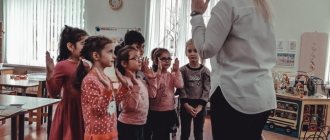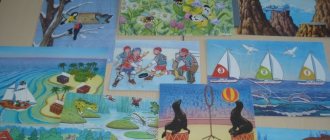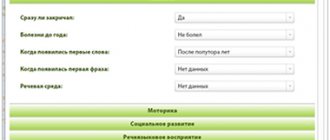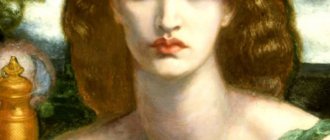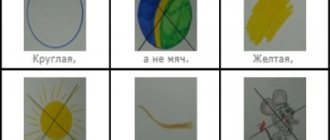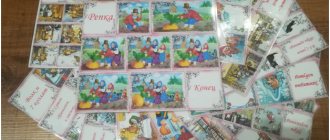Mnemotables “Favorite Tales”
Good day! I really love doing theatrical activities with my students. In addition to performing at holidays and in theater productions, it is very important that group rooms have the necessary conditions for the development of children's creative potential. I present to you cards - mnemonic tables.
A mnemonic table is one of the most popular and effective techniques (mnemonics) that can be used to facilitate the process of memorizing and reproducing information by preschoolers, developing thinking and speech. In my mnemonic tables, there are sequential images in which the content of fairy tales is encrypted. When an adult listens to a fairy tale, the child remembers it not only by ear, but also by visual perception. He can retell a familiar fairy tale.
On the back of the cards I placed the fairy tale itself in the form of text. It is intended for a teacher, if suddenly he is not familiar with this fairy tale or has forgotten some details.
I took pictures of fairy tales from the Internet, but mainly from this site: https://www.detiam.com/
Next, I want to offer my colleagues the opportunity to use my work.
Wolf and 7 kids. Table DOCX / 2.8 MB Wolf and 7 kids. Text DOCX / 14.18 KB Zayushkina's hut. Text DOCX / 14.93 Kb Zayushkina's hut. Table DOCX / 2.8 MB Kolobok. Table DOCX / 4.27 MB Kolobok. Text DOCX / 19.28 Kb Who said meow. Suteev. Table DOCX / 22.51 KB Who said meow. Suteev. Text DOCX / 753.89 Kb Chicken Ryaba. DOCX table / 3.65 MB Chicken Ryaba. Text DOCX / 12.63 Kb Chanterelle with a rolling pin. Table DOCX / 796.68 KB Chanterelle with a rolling pin. Text DOCX / 17.42 KB Little fox-sister. Table DOCX / 542.95 KB Little fox-sister. Text DOCX / 16.21 KB Masha and the Bear. Table DOCX / 687.65 Kb Masha and the Bear. Text DOCX / 17.88 KB Comb cockerel. Table DOCX / 774.23 Kb Comb cockerel. Text DOCX / 18.04 Kb Under the mushroom. Suteev. Text DOCX / 17.19 Kb Under the mushroom. DOCX table / 1.01 MB Turnip. DOCX table / 5.51 MB Turnip. Text DOCX / 14.51 KB Teremok. Table DOCX / 605.37 KB Teremok. Text DOCX / 16.55 Kb Three kittens. Suteev. Text DOCX / 18.4 Kb Three kittens. Table DOCX / 539.71 Kb Three bears. Table DOCX / 706.85 Kb Three bears. Text DOCX / 16.98 Kb The Three Little Pigs. Table DOCX / 1.1 MB Three Little Pigs. Text DOCX / 24.51 Kb Chicken and duckling. Suteev. Text DOCX / 17 Kb Chicken and duckling. DOCX table / 577.2 KB
Summary of GCD for speech development. Topic: “Wild animals. Squirrel
Summary of educational activities for speech development. Topic: “Wild animals. Squirrel".
Senior group.
Target:
-continue to expand and deepen children’s knowledge about wild animals (squirrels).
-develop the ability to compose a story based on a mnemonic table
Tasks:
Educational:
-To form children’s ideas about protein, appearance, and lifestyle.
— develop children’s skills in using a mnemonic table when composing a story about an animal;
-Improve the ability to grammatically correct and consistently construct your statements. Encourage children to answer questions by pronouncing words clearly.
Educational:
Strengthen the ability to write short stories about protein using a mnemonic table;
— develop children’s speech, expand their vocabulary;
— create conditions for the development of attention, memory, logical thinking, auditory and visual perception;
-develop the ability to work independently;
Educational
:
- to instill in children a love and respect for nature.
- cultivate a respectful attitude towards peers, the ability to listen to the teacher, without interrupting comrades;
Materials and equipment
: pictures depicting an autumn forest, wild animals, illustration to a fairy tale by L.N. Tolstoy "The Squirrel and the Wolf" mnemonic table,
Location
: group room
GCD move:
Organizing time:
The teacher shows the children a picture of an autumn forest.
Educator
: Guys, today we will take a walk through the autumn forest and maybe we will meet its inhabitants there. Tell us what animals we can meet in the forest.
Children:
hare, hedgehog, fox, squirrel.
Main part:
Educator:
Many animals set up storerooms with supplies in the forest.
What animals do you know that make storage rooms for the winter?
Children:
chipmunks, squirrels, mice.
Educator:
Today we will talk about such an animal. Listen to the riddle about him:
I walk around in a fluffy fur coat,
I live in a dense forest.
In a hollow on an old oak tree
I'm gnawing nuts.
Children:
Squirrel
Educator:
Why did you guess that the riddle was about a squirrel?
Children:
A squirrel lives in the forest, in a hollow. She has a fluffy coat.
Educator:
I suggest you play a game, look at the pictures and tell how the animals are similar and how they differ.
Educator:
At the end of autumn, the squirrel will change its coat from red to gray. Why do you think? Who else changes their fur coat for winter?
Children:
In order to be invisible, to hide from enemies. The bunny also changes his fur coat from white to gray so that in winter a wolf or fox won’t notice him in the snow.
Educator:
Yes, guys, you are absolutely right, well done. The squirrel's enemies in nature wait for them on the ground, hide in the foliage and look out for their prey from the sky. Foxes and wolves hunt for the animals. Every time a little squirrel climbs down from a tree, it is in danger. But even on the tree there are terrible enemies in wait for her: weasels, martens, wild and feral cats, lynxes. Large birds: owls and hawks are also natural enemies of squirrels in nature. In autumn, the trees in the forest remain without leaves, everything around becomes gray and the bright, red squirrel is very noticeable, so it changes color, and its coat also becomes warmer.
Educator:
The squirrel makes substantial reserves for the winter. They store excess food in reserve for the winter. Because in winter it can be very cold and everything around is covered with snow. Therefore, it is very difficult to get food. Squirrels build pantries in hollows or bury food in the ground between roots; sometimes squirrels forget where they made their pantry. She finds them by accident, which makes her very happy. And sometimes other animals find and eat squirrel supplies. The squirrel also stores a lot of mushrooms for the winter. He also hides dried mushrooms in his pantries. For mushrooms, the squirrel will then eat only the cap and throw away the stem. In addition to mushrooms and nuts, the squirrel stores acorns for the winter.
Educator:
Acorns - what tree are they from?
Children
: From oak.
Educator:
And here’s how a squirrel hides its prey: it digs a hole, carefully puts the prey in it, and rakes up dirt and dry leaves on top so that other forest inhabitants don’t find it.
Educator:
“If you put it further away, you’ll take it closer.” How do you understand this proverb?
Children
: If you hide it well, no one will find it or eat it.
Educator:
Sometimes it happens that squirrel reserves are eaten. But the squirrel itself, if it comes across someone else’s supplies in winter, will not be shy and will eat them. Some of the reserves will remain uneaten. This will benefit the forest: after all, in the spring they will take root and sprout, and then they will grow and become large trees.
Educator:
Guys, let's play with our fingers.
Finger gymnastics “Squirrel sitting on a cart”
A squirrel sits on a cart and sells nuts.
(Children clap their hands and alternately hit fist on fist)
To the little fox-sister, to the sparrow, to the titmouse, to the thick-fingered bear, to the mustachioed bunny.
(Children bend their fingers for each animal name).
Educator:
When severe frosts set in, you won’t see the squirrel. She can curl up in a ball and sleep for several days. In addition to its reserves, the squirrel feeds on pine cones. He picks a cone from a branch and makes himself comfortable somewhere among the branches. It holds the cone in its front paws, bites off the scales of the cone with its teeth, and takes out the seeds. If its reserves are not enough, the squirrel eats bark, young shoots, and buds. But in the summer, the squirrel’s diet is varied with the larvae of various insects, ant and bird eggs, and, on occasion, chicks, as well as berries, fruits, willow and aspen catkins.
For housing, the squirrel builds one main nest for the winter and 2-3 flight, spare ones. These spare nests are like summer houses, where the squirrel rests, hides from predators, and waits out the summer heat. If suddenly the baby squirrels are in danger, he drags them to these spare nests. Summer nests are light and windblown. But the winter nest is woven and skillfully built, insulated. There are, however, not very hardworking squirrels who adapt magpies' and crows' nests as nests, driving the housewives out of them. They say about the squirrel that she is nimble, cocky, and businesslike.
Educator
: Let's look at the meanings of these words. What does "nimble" mean? "cocky"? "busy"?
Children:
She quickly jumps along the branches, is always busy, does not sit still.
Educator:
Guys, listen to L.N.’s fairy tale. Tolstoy "The Squirrel and the Wolf"
"Squirrel and Wolf"
The squirrel jumped from branch to branch and fell straight onto the sleepy wolf. The wolf jumped up and wanted to eat her. The squirrel began to ask:
- Let me in.
Wolf said:
“Okay, I’ll let you in, just tell me why you squirrels are so cheerful.” I’m always bored, but I look at you, you’re up there all playing and jumping.
Belka said:
“Let me go up the tree first, and from there I’ll tell you, otherwise I’m afraid of you.”
The wolf let go, and the squirrel went up a tree and said from there:
“You’re bored because you’re angry.” Anger burns your heart. And we are cheerful because we are kind and do no harm to anyone.
After reading the fairy tale, the teacher shows the illustration;
Educator
: Guys, pay attention. How the artist painted the squirrel and the wolf.
Children:
The squirrel is good, but the wolf is evil.
Educator
: Baby squirrels are born tiny, naked, and blind. Within a month, the baby squirrels’ eyes open and their bodies are covered with delicate fur. And very soon they will become such spoilers and bore their mother so much with their antics that she goes to a spare nest and takes a break from her restless children. But by nightfall, having rested, she returns to the children. After all, a squirrel is a caring mother.
If an enemy attacks, the squirrel tries to lead him away from the nest, running away along tree trunks. Sometimes he pretends to be dead and falls to the ground. It happens that while saving babies, a squirrel dies.
As soon as the baby squirrels grow up, they leave their parents. The daughter squirrels will go into independent life a little later. Old squirrels live in the same place, and young ones settle in a new one.
Educator:
I suggest you rest and move around.
Logorhythmic game “To the watering hole”
Target:
development of coordination of speech with movement, imitation, creative imagination.
On a hot day along a forest path
The animals went to water. (Children calmly walk one after another.)
The elk calf stomped behind the mother elk, (They walk, stomping loudly.)
A little fox was sneaking behind the mother fox, (They sneak on their toes.)
A hedgehog rolled behind the mother hedgehog, (They crouch and slowly move forward.)
A bear cub followed the mother bear, (They waddle.)
The baby squirrels jumped after the mother squirrel, (They jump in a squat.)
Behind the mother hare are the slanting hares (They gallop on straight legs.)
The she-wolf led the wolf cubs behind her. (They walk on all fours.)
All mothers and children want to get drunk. (Turning their face in a circle, they make movements with their tongue - “lap”
.)
Lesson summary:
Educator:
Guys, let's remember what we learned new about protein. And in order to help you tell it, I offer you a picture with which you can make a short story about a squirrel.
Children who wish can compose a story using a mnemonic table.
Common speech problems in preschool children
In most cases, girls and boys of preschool age should already be able to fully operate with synonyms and a variety of images, describe all current events, using vivid, but at the same time grammatically correct word forms. But, unfortunately, not all preschoolers can boast of such skills. Most children face various speech problems:
- Inability to compose long, complex sentences - the child’s speech consists exclusively of simple, laconic sentences.
- The child cannot independently formulate a logically correct and complete sentence.
- Systematic use of non-literary vocabulary.
- Minimal, poor vocabulary that does not correspond to the child’s age category.
- A preschooler cannot independently formulate questions and answer questions posed.
- Poor level of diction.
- A preschooler cannot draw correct logical conclusions and statements.
To correct such speech defects, mnemonics are often used, which have become widespread among many specialists.
Features of using mnemonic tables for teaching children
Today, mnemonics are one of the easy-to-use, easy, convenient and highly effective techniques for the development of coherent children's speech and accelerated memorization of material, which are implemented through schematic mnemonic tables and graphic images.
At the same time, this technique helps to formulate the baby’s speech, replenish his vocabulary with beautiful, complex and correctly constructed phrases and sentences. The essence of all mnemonic techniques is the transformation of textual, verbal information into visual images. Despite the fact that many preschool-aged children perceive their first lessons very painfully, believing that they will not succeed, in the future the children really enjoy the educational process. Not only is it extremely informative, but it is also very interesting, engaging and fun, like a game.
Most often, in the case of using mnemonic tables for the development of coherent speech of preschoolers in preschool institutions, the following scheme is used:
- The teacher shows the children cards with bright and colorful pictures indicating a certain phrase or sentence.
- The next stage is the study of so-called mnemonic tracks. This is a series of pictures, consisting of about four images, with the help of which the child can tell a simple story.
- The most difficult stage is the direct use of the mnemonic table for teaching coherent speech to preschoolers. Thanks to this method, preschool children learn to reproduce longer and more complex stories and stories.
Varieties of mnemonic devices for the development of coherent speech in preschoolers:
- Cards with an algorithm for certain actions - for example, the sequence of morning activities (washing, brushing teeth, breakfast, getting dressed).
- Mnemonic tracks with a series of different images that tell a specific story or story. For children of primary preschool age, fairy tales are most often used.
- Techniques for faster and easier assimilation of information and study of poetry.
An example of using the fairy tale “The Three Little Pigs”.
An example in the use of a poem.
What is mnemonics?
Mnemonics – literally translated from Greek means “the art of memorization.” This is a certain system of techniques and methods, the action of which is aimed at the most effective preservation, reproduction and memorization of the received material.
The name of this technique is absolutely no coincidence - it comes from the name of the ancient Greek goddess of memory, logic and prudence named Mnemosyne. Mnemonics is a popular technique, the essence of which is the most accelerated development of coherent speech, based on the visual perception of information with its further reproduction using images.
The main point of using a mnemonic table for children is the following: to determine a specific word or phrase, a specific image (picture) is used, with the help of which a schematic sketch of the word is made. By carefully studying the presented images, the child can quickly memorize and reproduce text material, which helps the development of speech for preschoolers.
